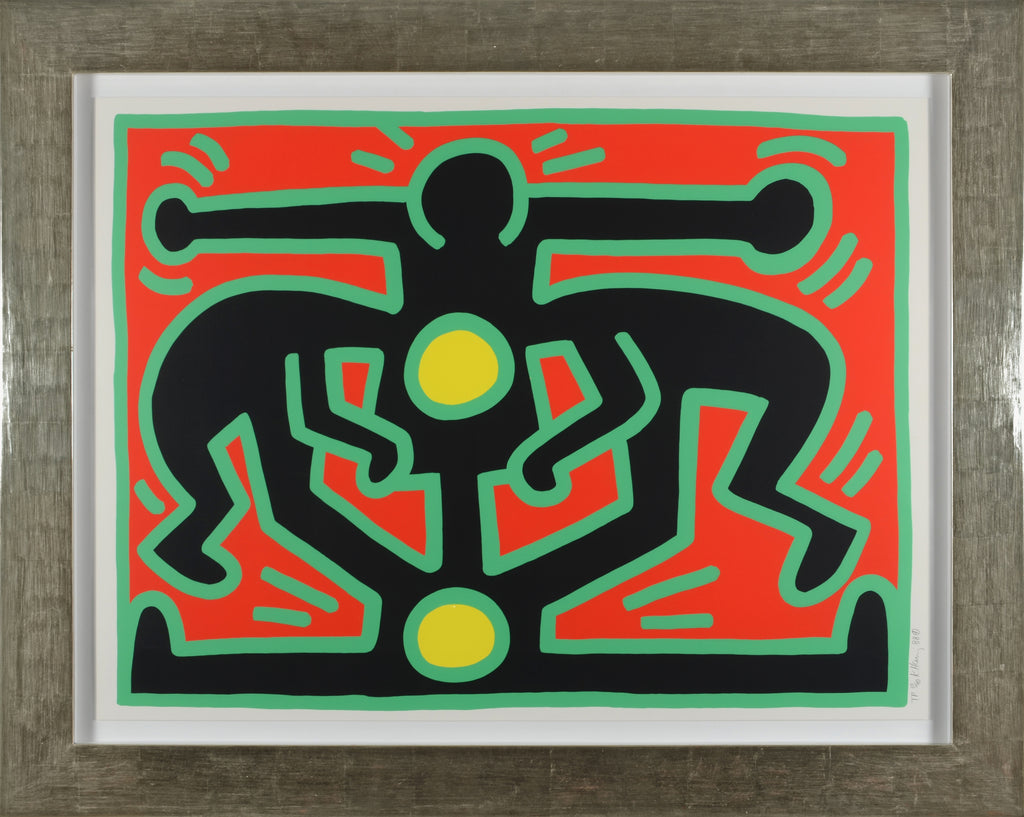Upload a photo of your space
For best results we recommend marking 10 inches on your wall with tape to get a sense of scale. Make sure to have the floor visible in the photo.


About the Work
"Growing #2" is a unique trial-proof screenprint created by Keith Haring in 1988 for his 'Growing' series. From the edition of 192, the unique trial-proof is signed and dated 'K. Haring 88' lower right. The image size is 30 x 40" and the artwork is framed in a custom, closed-corner, gold leaf frame. The artwork ships framed and accompanied by a certificate of authenticity.
Dubbed “a child of Pop Art,” Keith Haring swiftly ascended to be among the genre’s royalty when his career soared in the 1980s. With iconic line-work and bold colors, Haring seamlessly embraced tropes of commercial culture while creating a wholly unique body of work that pushed against the status quo. As Haring wove together high and low, so too did his subject matter ricochet between tragedy (including the AIDS crisis and South African apartheid) and pure, infectious joy of being. The 1988 Growing Suite exemplifies the latter — the series bursts with vibrant color and bodies-in-motion, a style that is pure Haring and an homage to 1980s dance styles – electric boogie, break-dancing, and vogueing, to name a few.
“Because the hand is central to Keith’s process,” Jeffrey Deitch says, “his work comes right out of his body.” This notion of Haring’s prints as a mobile extension of the artist’s body emanates from the Growing Suite, both in its ecstatic, interconnected content and the chosen medium of screen printing. In subject, the works bear similarity to the Pop Shop I and Pop Shop II series of that same era; all three series feature Haring’s iconic human figures in various stages of movement and convergence. As its title suggests, Growing’s forms are transitory, in-process, and, significantly, interdependent. Circles appear (often interchangeably) as heads and abdomens within the series, suggesting seeds and sources of origin. In one work, a single figure branches upward and outward into multiple figures like a tree growing towards the sun. That upward thrust appears again in the “people ladder,” where a smaller, child-like figure appears lifted into being by two supporting figures.
That Haring so readily adapted his inherently intimate medium — drawing — for purposes of reproduction is integral to his particular genius and legacy. “Whatever [Haring] carried out, he tended towards swift dissemination, duplication and ubiquitous application,” Werner Jehle wrote in his introduction to Keith Haring: Editions on Paper 1982-1990. While such “ubiquity” may for some preclude Haring from an academicized art historical canon, it is arguably his embrace of an inclusive, pluralistic vision of humanity that imbues his work with so much power. Deitch nods to Haring’s deliberate universality, offering “[Haring] is one of the primary links between hip hop from the South Bronx, gay dance club culture, the conceptual art culture of the Lower East Side, and street art culture. He put all these things together. In his lifestyle and his circle, and, obviously, in his art.” As a microcosm of Haring’s career and life, Growing expresses Haring’s belief in the power of collective action and the interconnectedness of humanity. The figures’ simplified forms, rendered without hierarchy, have an archetypal quality that feels as fresh today as it did when first created.
Haring’s regular editions are desirable in their own right, as in Growing #1 above, the most popular image in the series. However, two of these particular prints are unique trial-proof screenprints. Growing #2 and #3 feature experimental combinations of color — subtle variation in #3 and bold departure in #2. Unlike the regular edition prints, each trial proof is one of a kind, effectively blurring the line between printmaking and unique work. Collectors prize trial proofs for exactly this reason: they carry the aura of originality while also belonging to an iconic series.
About the Artist
Keith Haring was a social activist and artist who wasn’t afraid to depict and publicize controversial topics such as war, sexuality, life, and death with his art. Haring used New York City - the walls, stations, and buildings - as his canvas, creating masterpieces for the public eye. His signature cartoon style combined his outspoken political and social activism place Haring amongst the legends in the art world. Born May 4, 1958, in Reading, Pennsylvania, Haring grew up fascinated by the cartoon art of Walt Disney, Charles Schultz, and even Dr. Seuss. Haring’s father also drew cartoons as a hobby in his free time, inspiring a young Haring to perhaps make his own one day. Eventually, as a grown man, he moved to New York City to enroll at the School of Visual Arts. It is there Haring found his artistic peers and social niche and became acquainted with Jean-Michel Basquiat and Kenny Scharf, among other individuals in the underground art scene.
Please utilize the AR experience in a well-lit room.
Scan the room for surface detection.

Artwork will place in your room.
Using your fingers, align the horizontal white line
with your floor.

Double tap the artwork to scale to 100% size
and pinch to move on the screen.










